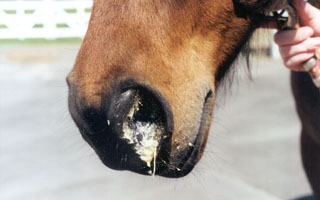
| This horse has some significant nasal discharge. This discharge would be described as purulent and may be associated with a strangles infection. |
Introduction:
Any discharge from the nose can be categorized in one of four major categories. These categories are serous (watery), purulent (colored/infectious), hemorrhagic (bloody or blood-tinged), and feed containing, or a combination of the above. Many problems and diseases that involve the lungs, sinuses, guttural pouches, and related structures can cause nasal discharge.Causative Agents: The following lists are only a few of the major causes of nasal discharge in the horse.
- Bacterial infections (strangles and pneumonia)
- Guttural pouch empyema or chondroids (condensed infectious material)
- Fungal infections
- Abscesses in the lungs or upper airways
- Some tumors, polyps, and cysts
- Infections resulting from foreign bodies
- Tooth problems
- Exercise induced pulmonary hemorrhage (EIPH)
- Ethmoid hematomas (blood tumors)
- Erosive tumors, polyps, and foreign bodies
- Guttural pouch problems (tumors, infections)
- Toxic plants and substances
- Congenital defects (cleft palate)
- Choke
- Blockage of the esophagus due to strangles infections
- Any disease that causes damage to the muscles and nerves in the throat and neck region (tetanus, botulism, rabies)
- Plant toxicities
- Other problems or injuries to the esophagus or stomach (ulcers, etc.)
Clinical Signs:
The most easily observed sign is abnormal discharge from the nose. This discharge can be serous (watery), purulent (colored/infectious), hemorrhagic (bloody or blood tinged), may contain feed, or involve a combination of the above. Some of the conditions listed in the causative agents section can cause a fever, coughing, and severe discomfort, in addition to the nasal discharge. For a more detailed discussion on the clinical signs, refer to the specific problem in this manual.Diagnosis: A detailed history is essential in determining a cause. Some of the key elements in a history include providing answers to the following questions:
Before taking a horse to the veterinarian, it might be beneficial to consider the above questions.
At the veterinary clinic, a history is taken and a thorough physical exam is performed. This exam may include listening to the lungs and trachea, taking a temperature, and examining the nose and mouth. One of the most beneficial tools available at many clinics is endoscopy (see page D200). Endoscopy is a procedure where a small camera is inserted into one of the nostrils, the sinuses, guttural pouches, esophagus, stomach, and even the lungs. This instrument allows the practitioner to look for any abnormal structures (foreign bodies, fungal and bacterial infections, tumors, and choke), take samples for cultures/histopathology, and examine the entire respiratory tract and some of the digestive tract. In some situations, a radiograph (X-ray) may be required to reach a diagnosis.
Treatment: As in many other situations, the exact treatment is based on the specific problem. In general, many of the infectious causes for nasal discharge can be treated with antibiotics, rest, and careful management. Objects like foreign bodies, ethmoid hematomas, and other tumors often require surgical removal. In many of the guttural pouch diseases, some tumors, and some foreign bodies can be removed and/or treated using endoscopy. For additional treatment information, refer to the specific problem in this manual.
Prevention: Some of the causes of nasal discharge can be prevented by maintaining a good vaccination program (see page A905). This program should be coupled with sound management practices and careful daily observations of each animal. As is the case with almost every disease, it is always best to contact a veterinarian as soon as a problem arises. Waiting can cause serious problems, and even death in some situations where the nasal discharge is hemorrhagic, and/or involves the guttural pouches. For additional prevention ideas, refer to the specific problem in the Equine Manual.

|
|